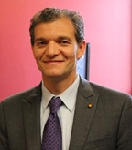Day 2 :
Keynote Forum
Mahdi M Abu-Omar
Purdue University, USA
Keynote: Polymers from sustainable and renewable sources
Time : 09:00-09:25

Biography:
Abu-Omar completed his PhD from Iowa State University and postdoc from Caltech. He is the R. B. Wetherill Professor of Chemistry at Purdue University, and thernassociate director of the Center for Catalytic Conversion of Biomass to Biofuels (C3Bio), an Energy Frontiers Research Center. Mahdi is the Founder and Presidentrnof Spero Energy, Inc., a green specialty chemicals company and a technology provider for the manufacture of high value renewable chemicals from biomass. Hernhas published more than 100 original research papers in peer-reviewed journals. Dr. Abu-Omar is a Fellow of the American Association for Advancement of Sciencern(AAAS).
Abstract:
Polymers have truly transformed our way of life from electronics to food packaging. Annual production of polyolefins alone isrnprojected to grow to nearly 170 billion kg by 2018. Phenolic resins are another family of polymers and oligomers composedrnof a wide range of structures based on the various reaction products of phenols with formaldehyde. Applications vary fromrncommodity construction materials to high technology applications in electronics and aerospace. Worldwide consumption ofrnphenolic resins exceeds 10 million tons; the largest volume application is in plywood adhesives and accounts for ca. 50% ofrnU.S. consumption. Given that both of these major polymer classes are derived from petroleum-based monomers and withrnincreasing environmental constraints, major opportunities can be explored in research and commercialization for making highrnperformance materials from renewable sources. Potential approaches for making polymers with outstanding durability andrnease of formability to complex contours will be discussed; and how monomers that do not compete with food can be utilizedrnand expanded. A balance to meet performance, sustainability, and biodegradability must be considered.
Keynote Forum
Craig L Hill
Emory University, USA
Keynote: Green syntheses to green fuel. Lessons that translate from one to the other

Biography:
Craig L Hill trained at MIT (PhD; Whitesides) and Stanford (NSF PD; Holm) and is the Goodrich C. White Professor of Chemistry at Emory University. He studies\r\ncatalysis (green oxidations; multielectron processes, decontamination, others), mechanisms and materials. He has trained ~130 graduate students and postdocs.\r\nGoogle Scholar lists ~340 journal publications that are cited 20,065 times (H index = 72). Three of these already exceed 1000 citations. He has been the recipient\r\nof three ACS awards, many others and is a member of two academies
Abstract:
Key lessons learned during the development of green chemistry over the last 25 years have several direct ties to green energy\r\nchemistry. Among these include approaches to optimize both turnover rates and product selectivity in catalytic reactions\r\n(organic transformations and energy production). Another is the systematic manipulation of oxygen chemistry (from H2O\r\nto H2O2 to O2) to avoid selectivity-deleterious and energetically-undesirable oxygen-based intermediates. A third involves\r\nparadigm development for catalyst stability. (Recall that selectivity in all catalytic reactions depends on many parameters\r\nbut chief among them is retention during turnover of the geometrical and electronic structure of the catalyst itself.) A forth\r\nbridge between the 2 large research areas is incorporation of green design principles in reactor design and other aspects of the\r\nreactions.
Keynote Forum
J S Yadav
Indian Institute of Chemical Technology, India
Keynote: Green methods for new chemical entities (NCE’s)
Time : 09:00-09:25

Biography:
J S Yadav completed his PhD from M.S. University, Baroda and Postdoctoral studies at Rice University, Houston, USA. He was the Director of the prestigious Indian Institute of Chemical Technology, Hyderabad for over a period of 9 years and presently is serving as CSIR Bhatnagar Fellow at the same Institute, a premier scientific research organization. He has published more than 1100 papers in reputed journals and has been serving as an Editorial Board Member of repute. He received several prestigious awards and honors like CSIR Shanti Swarup Bhatnagar Award in the year 1991, Fellow of Indian Academy of Sciences (FASc) in the year 2010 and Highest honor as Laureate of the 22nd Khwarizmi International Award for his excellent contributions as a research scientist.
Abstract:
Water mediated organic reactions are very useful in view of environmental consciousness. Therefore, organic transformations that are performed in water will be discussed in details. In particular, transition metal catalyzed transformations in the synthesis of heterocycles will be discussed. The use of water tolerant Lewis acids such as indium salts, scandium triflate will be demonstrated for the C-C, C-N and C-S bond formation. In addition, a few indium-mediated transformations like Barbier type allylation reaction of carbonyl compounds, epoxides, acetals, reduction of N-oxides and reductive alkylations of azides which are performed in water will be discussed as they are simple, convenient and environmentally friendly.
- Track 2: Green Chemistry-Chemical Applications from Laboratories to Industries
Track 8: Organic Synthesis in Different States
Track 10: Analytical Methodologies
Track 11: Sustainability and Environmental Safety
Location: Hyatt Regency Orlando International Airport
Session Introduction
Mahdi M Abu-Omar
Purdue University, USA
Title: Sustainability through Catalysis: Making Biofuels and Chemicals from Biomass

Biography:
Abu-Omar completed his PhD from Iowa State University and postdoc from Caltech. He is the R. B. Wetherill Professor of Chemistry at Purdue University, and the associate director of the Center for Catalytic Conversion of Biomass to Biofuels (C3Bio), an Energy Frontiers Research Center. Mahdi is the Founder and President of Spero Energy, Inc., a green specialty chemicals company and a technology provider for the manufacture of high value renewable chemicals from biomass. He has published more than 100 original research papers in peer-reviewed journals. Dr. Abu-Omar is a Fellow of the American Association for Advancement of Science (AAAS).
Abstract:
Transition metal catalysts have been an integral part of the success story of the petrochemical industry in the past century. Two grand challenges for this century are renewable energy and the utilization of green resources. Approximately 1.4 billion tons of lignocellulosic baiomss is an annually renewable source of energy and feedstock in the U.S. alone. The major components of biomass are cellulose, hemicellulose/xylan, and lignin- all polymeric and contain high percentage of oxygen. Current biomass utilization processes do not make use of lignin beyond its heat value. We have developed selective catalysts that convert lignin in intact wood biomass directly into two methoxyphenol chemicals, DHE and DMPP, leaving behind the carbohydrates as a solid residue. The lignin-derived methoxyphenols can be deoxygenated further to hydrocarbon fuels. Furthermore, the carbohydrate solid residue can be hydrolyzed and converted to fuels and chemicals via simple cascade catalytic reactions. Based on these results, a synergistic biorefinery is proposed in which both the lignin and carbohydrate fractions are utilized to make fuels and chemicals.
Lothar Brecker
University of Vienna, Austria
Title: Natural Products as Active Agents: On the Border between Sustainable Application and Risky Use

Biography:
Lothar Brecker received his diploma and PhD in Chemistry from the University of Dortmund in 1993 and 1996, respectively. After working at Graz University of Technology and Research Center Borstel, he became an Associate Professor at the University of Vienna. There he actually serves as Vice Dean of the Faculty of Chemistry, Director of the Chemistry Studies Program and Deputy Head of the Department of Organic Chemistry. His main research activities are in the fields of using NMR to study enzyme ligand binding, interactions between small molecules, and structure determination of natural products. He has published 90 papers in reputable journals.
Abstract:
Natural products from renewable resources have been applied in all parts of the world since beginning of time. It is hence obvious to use compounds from natural origins nowadays in sustainable concepts of Green Chemistry. Typical applications can be found in the fields of plant protecting agents, food additives and pharmaceutical drugs. However, an uncritical application of natural products can cause several problems. Nature optimized structures and concomitant functions of “applicable” natural products much earlier than human beings lived on earth. Therefore these compounds are not adapted to our necessities and we use them for purposes and in environments completely different from those originally intended by nature. Effects of the natural products to humans are also often influenced by structural changes during isolation or by formation of complexes in combined use with other compounds. The possibilities of these alterations have to be considered within isolation procedures and applications to avoid difficulties caused by unwanted effects of modified compounds from natural sources. Three examples are presented, which exemplary show chances and risks in the work up and application of natural products. First one deals with antifungal activity of compounds from Glycosmis species and structural changes during their isolation. The second example shows different chemical structures in the morphological very similar plants Carapichea ipecacuanha (Ipecac) and Ronabea emetica (false Ipecac), both causing comparable pharmaceutical effects. Finally the use of highly toxic aconitine from Aconitum carmichaelii in the Chinese tea ‘Si Ni Tang’ (SNT) is discussed.
Febee Louka
University of Louisiana, USA
Title: Comparing the effect of ecofriendly adsorbents and bioturbators on the concentration pyrene

Biography:
Febee Louka has completed her PhD in 2004, from Ohio University in Medicinal Analytical Chemistry. She is Associate professor in Analytical/Environmental Chemistry, at the University of Louisiana at Lafayette (ULL). She is a CoPI in million dollars grant on effect of oil spills. She was awarded the Outstanding Undergraduate Research Mentoring in 2014. She is also the awardee of Marvin and Warren Boudreaux / BoRSF Professorship in Chemistry at ULL (2012-2018). She was awarded the Summer Research Award Summer 2012. She has published more than 27 papers in peer reviewed journals and over 25 presentations in National and International meetings.
Abstract:
In the present study we intended to investigate and compare two methods that can be applied in case of oil spills. The waste produced in Louisiana such as sugarcane “Sacharum Officinarum” bagasse and crawfish “Austropotamobius pallipes” shells were used as low cost ecofriendly adsorbents. These adsorbents were used to examine the removal of pyrene one of the most abundant polycyclic aromatic hydrocarbons (PAHs). Pyrene is the precursor of benzo(a)pyrene the most common PAH to cause cancer. Sediment and water dosed with a known concentration of pyrene were used in this study. Microcosms containing beach sediment, seawater and bioturbators (the ghost shrimp “Lepidophthalmus louisianensis” or the razor clams “Tagelus Plebeius”) and dosed with pyrene were used for this study. Water, and sediment (surface and subsurface) samples were analyzed to determine the concentration of pyrene in them. The influence of bioturbators on biodegradation and distribution the petroleum hydrocarbon under investigation in sediments of coastal ecosystems was tested in day 1 and day 15 from dosing day. Sediment bioturbators often function as ecosystem engineers, moving large amounts of sediment and changing sediment characteristics. During the biological transport of sediment, pyrene in the sediment will move as well. Pyrene in water samples was extracted using liquid-liquid extraction. Microwave Extraction was used for sediment samples. PAH under investigation extracted using both treatments were analyzed using gas chromatography with flame ionization detector (GC-FID). Preliminary results indicated that the concentration of pyrene decreased significantly using the sugarcane bagasse within hours, whereas it took days for crawfish shells to absorb pyrene. On the other hand, in presence of both the bioturbators especially ghost shrimp the concentration pyrene decreased compared to the controls that are under the same condition in absence of the marine animals.
Craig L. Hill
Emory University, USA
Title: Green fuel. Selective and water compatible catalysts for solar fuel production

Biography:
Craig L. Hill trained at MIT (PhD; Whitesides) and Stanford (NSF PD; Holm) and is the Goodrich C. White Professor of Chemistry at Emory University. He studies catalysis (green oxidations; multielectron processes, decontamination, others), mechanisms and materials. He has trained ~130 graduate students and postdocs. Google Scholar lists ~340 journal publications that are cited 20,065 times (H index = 72). Three of these already exceed 1000 citations. He has been the recipient of three ACS awards, many others and is a member of two academies.
Abstract:
In order to meet global requirements for environmental preservation and adequate energy for society, it will be necessary to develop green, sustainable sources of energy on a massive scale. Unfortunately the renewal energy sources don’t have the capacity to power the planet, with the exception of solar (terrestrial sunlight). Sadly, nuclear fusion still faces monumental challenges. In addition, we must have fuel energy, not just electrical energy because most major energy needs (air travel, shipping, etc.) require high-density energy. This explains the enormous international effort to realize solar fuel (do artificial photosynthesis). The 2 principal reactions in solar fuel production are splitting of water and reduction of CO2 by H2O to generate H2 and carbon-neutral fuel, respectively. The Hill group efforts have shifted in recent years from green catalytic selective oxidations of organic substrates to selective catalytic oxidative removal of toxic molecules in human and natural environments, and the extremely active research area of catalytic water oxidation, which is essential for making solar fuel. Many of the key requirements for successful, green oxidations of organic substrates and water are the same: catalysts that are highly selective, stable and fast and that proceed by known and controllable mechanisms to minimize waste and facilitate green operation. We will address these points and end with describing polyoxometalate (POM)-based water oxidation catalysts (WOCs) that are among the most effective, if not the most effective, homogeneous WOCs known at present.
Soon H. Hong
Seoul National University, Korea
Title: Atom-Economical and Sustainable C-N Bond Formation Reactions from Alcohols and N-Sources via Catalytic Hydrogen Transfer Reactions

Biography:
Soon Hyeok Hong obtained his PhD in 2007 at the California Institute of Technology, under the guidance of Professor Robert H Grubbs. After having Postdoctoral research experience at the University of California, Los Angeles and industrial experiences at Materia, Inc., he began his independent career in academia as an Assistant Professor at Nanyang Technological University with a joint appointment as a National Research Foundation Fellow of the Singapore government in 2008. In 2011, he moved back to his undergraduate school, Seoul National University, where he has been working on green organo metallic catalysis in developing efficient, practical, and sustainable synthetic methods.
Abstract:
Development of useful, practical, and selective synthetic methods that generate minimal by-product is of critical importance in both academic and industrial research. The research of our group seeks to develop practical and environmentally friendly synthetic methodology using transition metal catalysts. Specifically, we have explored novel C–N formation reactions from primary alcohols and various N-sources, chemical synthesis using CO2 and methanol as C1 sources, and development of organometallic catalysts based on N-heterocyclic carbene ligands. Direct C–N formation reactions from alcohols and N-containing molecules is a highly atom economical transformation producing hydrogen as the sole byproduct. Well-defined N-heterocyclic carbene based Ru complexes were developed as highly active pre catalysts based on the mechanistic insight suggesting a Ru hydride species as an active catalytic intermediate. With the developed catalysts, various novel C–N formation reactions for the synthesis of amides, imides, ureas, and amines were achieved. The developed catalytic systems involving hydrogen transfer have been also applied to CO2 reduction and methanol activation. With these sustainable C1 sources, reactions developments are actively ongoing in our group. Lastly, our recent researches on homogeneous catalyst development based on N-heterocyclic carbene and pincer ligands will be presented.
Miguel Yus
University of Alicante, Spain
Title: Atom and Step Economy in Synthetic Organic Chemistry

Biography:
Miguel Yus has completed his PhD in 1973 at the University of Saragossa (Spain) and postdoctoral studies from the Max Planck Institute in Mülheim Ruhr (Germany). After returning to the University of Oviedo (Spain) he became Associate Professor in 1978 and full Professor in 1987 at the same university. In 1988 he moved to his current position at the University of Alicante (Spain). He has been invited professor at the ETH Zürich, and the universities of Oxford, Harvard, Uppsala, Tucson, Okayama, Paris, Strasbourg, Bologna, Sassari, Tokyo, and Kyoto. He is coauthor of more than 500 papers and 5 patents.
Abstract:
One important task concerning any chemical process has to do with the so-called atomic efficiency (AE), which can modify considerably the concept of yield corresponding to a chemical reaction: even working with a high chemical yield a reaction can be not efficient when the main part of the reactants structure is not included in the final product. Two interesting processes will be the subject of this presentation: (a) The hydrogen autotransfer reaction, in which an alcohol is used as electrophilic component, for instance, in the alkylation of a carbonyl compound, water being the only byproduct in the process, that is, therefore, of great value from an atom efficiency point of view; and (b) the multicomponent reaction, such as the aza-Sakurai reaction, or the diastereoselective allylation of imines, of considerable interest from a step efficiency point of view.

Biography:
Xilin Xiao received his master degree of health toxicology from University of South China, PR China in 2004, and PhD in analytical chemistry in 2010 from Hunan University. From 2011 to 2012, he left to the University of Florida joined the WeihongTan’s Research Group as a visiting scholar. He is currently a full-time associate professor in the College of Chemistry and Chemical Engineering, University of South China, PR China. His primary research interests concern the chem/biosensors.
Abstract:
This paper describes the real-time quantification of human osteosarcoma cell (MG-63) concentrations and evaluation of the cytotoxicity of the anticancer drug cisplatin using a wireless magnetoelastic sensing device. The sensor is fabricated by coating a magnetoelastic ribbon-like sensor with a layer of polyurethane that protects the iron-rich sensor from oxidation and titanium dioxide nanotubes upon the surface of polyurethane provides a cell-compatible surface. The titanium dioxide nanotubes (TiO2 NTs) are easy to be dispersed at substrate and spread around on the surface of polyurethane. In response to a time-varying magnetic field, the magnetoelastic sensor longitudinally vibrates, emitting magnetic flux that can be remotely detected by a pick-up coil. No physical connections between the sensor and the detection system are required. The wireless property facilitates aseptic biological operation, especially in cell culture as illustrated in this work. The resonance frequency changes in response to properties changes of a liquid culture medium and cells adhesion to the sensor as MG-63 consumes nutrients from the culture medium in growth and reproduction. The adhesion of cells on the sensor’s surface results in a decrease in the resonance frequency and the amount of adhesion was proportional to the cell concentration. A linear response was obtained in cell concentrations of 1×104 ~ 2×107 cells mL-1, with a detection limit of 1×104 cells mL-1 at a noise level of 20 Hz.
Aiichiro Nagaki
Kyoto University, Japan
Title: Organolithium Chemistry Using Flow Microreactors to Green Chemistry

Biography:
I received his PhD in 2005 from Kyoto University under the supervision of Professor Jun-ichi Yoshida. I worked with Professor Hiroaki Suga, Tokyo University from 2005 as a postdoctoral fellow. In 2006, he became an assistant professor of Kyoto University. I was promoted to lecturer in 2013. My current research interests are organic synthesis, polymer synthesis, and microreactor synthesis. Awards: Takeda Pharmaceutical Co., Ltd. Award in Synthetic Organic Chemistry, Japan (2012), Incentive Award in Synthetic Organic Chemistry, Japan (2012), and Young Innovator Award on Chemistry and Micro-Nano Systems (2013).
Abstract:
Protecting-group-free synthesis has received significant recent research interest in the context of ideal synthesis and green sustainable chemistry. In general, organolithium species react with electrophilic functional groups very rapidly, and therefore such functional groups should be protected before an organolithium reaction, if they are not involved in the desired transformation. If organolithium chemistry could be free from such a limitation, its power would be greatly enhanced. A flow microreactor enables such protecting-group-free organolithium reactions by choosing the appropriate residence time and the reaction temperature. Organolithium species bearing alkoxycarbonyl, nitro, and ketone carbonyl groups can be generated and reacted with various electrophiles using a flow-microreactor system. In addition, asymmetric carbolithiation of conjugate enynes can be also achieved without the epimerization of a configurationally unstable chiral organolithium intermediate based on precise control of the residence time using a flow microreactor. In this presentation, we report that a flow microreactor system enables the generation of various unstable organolithium compounds.
Capucine Sassoye
UPMC University, France
Title: New Versatile Nanostructured Catalysts: from Green Preparation to Environmentally concerned Challenges

Biography:
Capucine Sassoye is Maitre de Conférences at UPMC. She is currently working on hybrid and inorganic nanomaterial, coupling the sol-gel chemistry with advanced processing to tune both the macroscopic shape and the texture of the materials. One particular research deals with sustainability, concerning both material synthesis and its further applications. She has so far authored/co-authored 25 peer-reviewed journal articles and given 5 presentations in international meetings.
Abstract:
Effective catalysts that could assess multiple environmental issues are nowadays needed, in a context of growing societal awareness and newly appeared environmental legislations. Challenges for these catalysts are numerous: Their production has to be as green as possible, fast and easy to handle; their use conditions have to be as soft as possible without compromising the requirements for high selectivity and high activity; they have to be nearly indefinitely reusable. These drastic requisites have oriented research toward soft preparation methods[1] leading to nanostructured heterogeneous catalysts in which very active species are designed at the nanoscale. Our work aims at developing innovative nanostructured ruthenium based catalysts with, as chosen fields of investigation, the methanation of CO2 (valorisation of CO2)[2], the total oxidation of volatile organic pollutants [3] (treatment of gas effluents from incineration and biomass cogeneration units) as well as soft conditions ammoniac synthesis [4]. In supported catalysis, although the primary role of the support is often thought to be limited to physical dispersant for intact metal active nanoparticles, it is now recognized that the metal-support interactions clearly influence the catalytic activities and/or selectivity. Moreover, supported RuO2 nanoparticles have clearly showed the ability to migrate over the support surface upon thermic treatment, this phenomenon being strongly support-dependent. This epitaxially-driven migration provokes decisive modifications in the catalyst and can be exploited to tune the catalyst active phase morphology, localization and thus activity.
Jennifer L Anthony
Kansas State University, USA
Title: Sustainable development of infrastructure for electric vehicles

Biography:
Jennifer L Anthony joined the Kansas State University chemical engineering faculty in 2005 and completed her PhD at the University of Notre Dame and her Postdoctoral studies at California Institute of Technology. Larry E Erickson has more than 50 years of experience as a member of the chemical engineering faculty at Kansas State University. His research with solar powered charge stations is supported by Black and Veatch and National Science Foundation projects 1156549 and 1460776
Abstract:
Over 3, 20,000 plug-in vehicles were sold in 2014. An infrastructure of solar powered charging stations (SPCSs) in parking lots that would provide electricity to the grid, shade for parked cars, and convenient electric vehicle (EV) charging at many locations would help both green electricity production and EV sales. Two significant green chemistry challenges are in solar energy and energy storage. New developments in batteries that would reduce costs significantly might reach a value of one trillion dollars. Convenience, availability, and shade are social benefits associated with SPCSs. Greenhouse gas emissions can be reduced significantly by adding SPCSs to parking lots in all parts of the world. In the US there is the potential to generate about 1/3 of the present amount of electricity with SPCSs in parking lots. Because EVs have no emissions, there is the potential to improve air quality throughout the world with EVs and SPCSs. The cost of SPCSs can be reduced through green chemistry that improves the efficiency of solar panels and the manufacturing process. One of the benefits of SPCSs and EVs is the reduced cost of transportation and the increased availability of petroleum and natural gas over the next 100 years.

Biography:
Deia Abd El-Hady has completed his PhD in Analytical Chemistry from Assiut University, Egypt joined with University of Bologna in Italy. He got postdoctoral grant by DAAD to study at Technical University of Braunschweig, Germany. Currently, he is an associate professor in University of Jeddah, Saudi Arabia. He has published more than 50 papers in reputed analytical journals.He included in the editorial board of several journals.
Abstract:
The analysis of analytes is considered one of the most challenges in capillary zone electrophoresis (CE). Fundamental studies on the new green separation of acrylamides by ionic liquid collapse capillary electrophoresis (ILCCE) are presented. The sample solution of the neutral analytes is prepared using ionic liquid 1-butyl-3-methylimidazolium bromide mixed with water as a dissolution solvent in order to increase the conductivity of the sample greater than the BGS. This separation mechanism was used to enrich the sensitivity separation of acrylamides with good resolution. Here, the effect of retention factor of the analyte, conductivity ratio of the sample and BGS, IL concentration in the sample and electrolyte salt concentration in the BGS were examined. A study on the effect of the injection technique to the performance of ILCCE is also presented. The new hyphenation of ILCCE with ionic liquid based ultrasound assisted liquid extraction was successfully applied to the rapid and selective analysis of acrylamide in breads.

Biography:
Medhat A. Shaker has completed his PhD at the age of 31 years from Alexandria University (Egypt) in collaboration with Northeastern University (USA). He is Associate Professor of Physical Chemistry at Damanhour University (Permanent, Egypt) and at University of Jeddah (Current, Saudi Arabia). He has published more than 25 papers in reputed journals and has been serving as a reviewer for a number of highly impacted peer-reviewed journals.
Abstract:
Solifenacin succinate, a pharmaceutical used in industry is an organic contaminant that has the potential to create environmental toxicity and pollution problems and cause health risks for humans as well as biota. Natural organic matters, such as humic acid, HA in aquatic environments can increase the stability of nanoparticles. In this work, solifenacin succinate in wastewater was removed by a biosorption method using HA-coated TiO2 nanoparticles. The FTIR, EDX and FESEM studies were used to characterize the fabricated nanosorbents. Mathematical adsorption and kinetics models representing the biosorption processes were formulated, supporting the Langmuir isotherm and pseudo-second order rate equation for the adsorption of aqueous solifenacin succinate using batch mode experiments. All parameters influencing the removal efficiency such as: adsorbent dose, medium pH, initial adsorbate concentration and temperature were considered for optimizing the experimental conditions. Thermodynamic study was carried out to describe the feasibility, thermic and entropic behaviors of the investigated biosorption process. The results showed that the method developed here is very effective for the removal of solifenacin succinate from an aqueous environment.
Sunil Joshi
National Chemical Laboratory, India
Title: De-polymerization of sugarcane bagasse lignin to value added products in sub and supercritical water

Biography:
Sunil Joshi leads a research group at the National Chemical Laboratory and has been active in the area of catalysis and Process development for the last 25 years. He has extensive experience in process intensification, scale up studies and responsible for several technology transfer in fine and specialty chemicals. Current research interests involve chemical applications of supercritical fluids, with particular emphasis on conversion of biomass to value added chemicals and carbon dioxide utilization. The focus is mainly at understanding the fundamental chemistry in supercritical fluids and at developing environmentally acceptable processes and materials.
Abstract:
The use of alternative solvents for development of cleaner and renewable processes for industrially useful chemicals is an important area of Green Chemistry. Biomass is a regenerative resource for energy and chemical production. Lignin is abundantly available and has potential to be utilized as renewable source for industrially useful chemicals. This work is associated with investigation of supercritical water as an alternative solvent in clean technologies. The lignins were de-polymerized at subcritical and supercritical conditions of water using oxidizing, non-oxidizing and catalytic environment. The effect of various reaction parameters such as pH, temperature, pressure, residence time and catalyst concentration was investigated. It was observed that the lignin on de-polymerization leads to catechol, vanillin, acetovanillone and homovanillic acid as major products while syringic acid and guaicol were found to be minor products. The lignin on de-polymerization under non-oxidizing conditions favors the formation of more hydrolyzed products resulting into formation around 15% monomers while under catalytic conditions gives around ~ 50 % monomer carbon balance. It has been observed that the lignins on de-polymerization under oxidizing conditions results into enhancement of the carbon balance from 25 % to 50 % due to formation of more break-down products. The continuous reactor designed in two sections resulted into enhanced de-polymerization of lignin. In the first stage the lignin polymer undergoes hydrolysis by breaking ether linkages while in the second stage catalytic oxidization of the oligomers formed occurs, which improved the yields of the break-down monomers significantly.
Kwang-Leong Choy
University College of London, UK
Title: Towards sustainable surface processing and products through green chemistry and engineering

Biography:
Kwang-Leong Choy obtained her D.Phil. from the University of Oxford in materials science. She joined Imperial College London in 1994 as a faculty staff. In 2002, she took up a Chair in Materials at the University of Nottingham. She is now a Director of the Institute for Materials Discovery at University College London. Her research interest focuses on the development of novel, cost-effective, sustainable non-vacuum chemical vapour processing of nanomaterials, functional superthin/thin films, nanocomposite coatings for various structural and functional applications in aerospace, clean energy, and materials engineering and biomedical sectors.
Abstract:
The global drive towards the reduction of energy consumption, emissions and minimisation of waste are increasingly important and becoming major technological, political and societal issues. A promising approach to address the current challenges is to adopt green chemistry and sustainability during process design, innovation, integration and optimisation. The use of green chemistry and process intensification in the processing of polymeric, inorganic and composite materials will be described. The emerging of eco-friendly and sustainable non vacuum chemical processing technologies will be presented for the production of nanostructured materials and high value added superthin/thin films and thick coatings. These processes that are not only low cost, less polluting, conserve energy, reduce waste but also increase efficiency and enhance product performance. Case studies leading to sustainable products and increasing profits for a variety of applications, including fine chemicals, clean energy, engineering, and biomedical sectors will be presented.
Pengxiang Zhao
Science and Technology on Surface Physics and Chemistry Laboratory, China
Title: Triazole Stabilized Transition Metal Nanoparticles for 4-Nitrophenol Reduction

Biography:
Pengxiang Zhao was born in Chengdu, China. He completed his PhD in 2012 in the group of Prof. Didier Astruc at the University of Bordeaux on the application of gold nanoparticles for docetaxel delivery. Then he did his post-doc at Hongkong Polytechnic University with Prof. Kwok-Yin Wong in 2013. He is currently an independent researcher at the Science and Technology on Surface Physics and Chemistry Laboratory at Mianyang, Sichuan, China. Now, he is leading a group there and his research interests concern nanomaterials and metal catalysis.
Abstract:
In the past few decades, a variety of ligands have been synthesized and used to stabilize gold nanoparticles (AuNPs) either in organic solvents or in water. The surface properties, including ligand type, binding force of Au with other atoms, as well as the ligand coverage of AuNPs control the solubility, stability and applications of AuNPs. For example, in thiolate-stabilized AuNPs,covalent bonding of Au-S contributes to the passivation of the surface of thiolate-stabilized AuNPs and makes AuNPs stable in solid state, whereas citrate stabilized AuNPs were usually prepared in aqueous solution due to themulti-package of ionic species on the AuNPs surface.2In addition, the influence of surface properties to AuNPs was also observed in several examples on the coordination-induced stabilization of AuNPs with nitrogen donors, particularly, dendritic supramolecules. PAMAM dendrimers shows significant template effects in the formation of NPs in various solvents. Copper-catalyzed azide alkyne (CuAAC) “click” chemistry has generatedsuper molecules such as PEG-terminated dendrimers and polymers also stabilizing AuNPs in aqueous solution. Besides, many other nitrogen ligandssuch as imidazoles, pyridines and others have also been utilizedfor the stabilization of AuNPs. In our previous reports, it is found that the copper-catalyzed azide alkyne (CuAAC) cyclyoaddition i.e. “Click” reaction could yield triazole functionalized PEG (triazole-PEG) to stabilize AuNPs by triazole-AuNPs (trz-AuNPs) bond in aqueous solution, and these AuNPs exhibited an excellent catalytic activity towards the 4-NP reduction. In order to extend the investigation of trz-MNPs for catalysis, we now report the full syntheses and characterizations on a group of triazole-PEG stabilized MNPs, then optimize and evaluate their catalytic reactivity towards the 4-NP reduction.
Mostafa Baghbanzadeh
Harvard University, USA
Title: Nanocatalysis and Continuous-Flow Processing: Towards Greener and more sustainable Chemistry

Biography:
Mostafa Baghbanzadeh completed his PhD in Organic Chemistry at Shahid Beheshti University of Tehran. Then, he joined Kappe’s lab at the University of Graz, serving as a group leader for studies on synthesis and application of nanocrystals using microwave and continuous-flow technologies. Since April 2013 he is a postdoctoral fellow in the Whitesides lab at Harvard University. He has published 53 publications in per-reviewed journals which are cited more than 2000 times, and his h-index is 25. His research interests are orgainc synthesis, catalysis, nanomaterials, green and sustainable chemistry, organic electronics, and reaction networks.
Abstract:
Colloidal nanocrystals (NCs) are solution-grown, nanometer-sized, inorganic particles that are stabilized by a self-assembled monolayer (SAM) of surfactants attached to their surface. NCs possess useful properties that are controlled by their composition, size and shape, and the SAM coating ensures that these structures are easy to fabricate and process further into more complex structures. This combination of features makes colloidal NCs attractive and promising building blocks for advanced materials, green chemistry, and specifically in catalysis. Colloidal NCs are potentially able to blend the many advantages of heterogeneous catalysis with the versatility of homogeneous catalysts. This presentation will focus on: i) Advantages of continuous-flow processing in in-situ preparation of Fe3O4 NCs from a Fe (e.g., FeCl2•4H2O, FeCl3•6H2O, and Fe(OAc)2) precursor using hydrazine hydrate as the reducing agent to catalyze the organic reactions (e.g., reduction of nitroarenes). ii) Shape-selective synthesis TiO2 colloidal NCs and their application in a continuous-flow photocatalytic transformation.
Nabil H Elsayed Khamis
National Research Center, Egypt
Title: Gelatin wastes for better plant growth

Biography:
Nabil Hussein El-Sayed khamis has completed his PhD at the age of 37 years from Politehnica University of Bucharest. He is the Eminent Professor at Chemistry of Tanning and leather Technology Department. He has published more than 90 papers in reputed journals and participation of 15 scientific conferences around the world.
Abstract:
Gelatin, E number: 441 is an animal protein derived through acid, alkaline, or enzymatic hydrolysis of collagen extracted from hides and or skin of boiled crushed bones, connective tissue organs, chicken, pigs and horses. It has many nutritional and industrial applications, mainly in food and pharmaceutical products. The worldwide production of gelatin is about 300.000 tons per year. Gelatin is unusually high in the non-essential amino acids as glycine, proline and hydroxyproline, while lacking certain essential amino acids. During its production it releases about 10% wastes which are not hydrolysed at production temperature 60°C. The aim of this work is to use these wastes instead of being thrown away causing environmental pollution. The wastes were hydrolysed using a mixture of H2SO4 and H3PO4 acids at pH=1 thus yielding a solution of 5% of amino acids, in addition to the valuable elements S, P, Zn, Mg, Mn, Fe, and K, the latter element was introduced through neutralization with KOH to pH=6 while Zn, Mg, Fe were present in the original waste. Because of the nature of the produced solution and to ensure ease application the shelf life of the produced amino acid liquids was improved to reach one year. The completely hydrolysed product was used as a nutrient to agricultural land and exhibited 37% increase in yield crops.
Yan Xiong
Southwest Petroleum University, China
Title: Fabrication of miniaturized capillary waveguide integrated fiber-optic sensor for fluoride determination in water

Biography:
Yan Xiong has completed her PhD at the age of 29 years from Dalian Institute of Chemical Physics, Chinese Academy of Sciences. Dr. Yan Xiong got the DICP-Corning Award, won a first prize from the China Association for Instrumental Analysis, and received the honor of Liaoning provincial excellent graduate. She has published more than 20 papers in reputed journals.
Abstract:
Fluoride concentration is a key aspect of water quality and has an essential role in human organisms. Too much or too little fluoride intake from water supplies is harmful to public health. In this work, a capillary waveguide integrated fiber-optic sensor was fabricated for in-situ measurement of fluoride in water samples. The sensor was modularly designed with three parts, including light source, capillary flow cell and detector. When light propagated from a light emitting diode (LED) to the capillary waveguide cell through an excitation fiber, it interacted with sensing reagents and its intensity changed with different fluoride concentrations. Then the light propagated to the detector through a detection fiber for absorption determination of fluoride according to Beer’s law. By using easily accessible capillary tube, silica fiber and cheap LED, the sensor was successfully miniaturized and fabricated with low cost for in situ measurement of fluoride. This miniaturized sensor showed advantages of fast analysis (9.2 s), small reagents demand (200 μL), lower detection limit (8 ppb) and high selectivity. Fluoride in different water samples were determinated using this sensor. The results obtained were compared with those obtained by conventional spectrophotometry, showing agreement and validating the sensor’s potential applications.
Olga V Shuvaeva
Novosibirsk State University, Russia
Title: The study of trace elements uptake by plants from contaminated waters

Biography:
Olga V Shuvaeva did her PhD in 1988, Dr. of Sci. in 2009 and is the Head of Environmental Chemistry Chair of Natural Sciences Department in Novosibirsk State University (Russia). She has published more than 100 papers in reputed journals. Her fields of interest are: the study of trace elements transformation and transport in Environment. She is an expert in analytical chemistry of natural media using atomic spectrometry and separation techniques.
Abstract:
The concept of green chemistry is focused on the prevention of environmental pollution as a result of human activity. However, there are a lot of contaminated areas in the world which pose a serious threat to ecosystems in terms of their conservation. Therefore, following the principles of green chemistry it should not be forgotten about the need to clean these areas. Phytoremediation technology is an effective sustainable, energy and cost economic method of environment clearing due to the plants ability to hyper-accumulation of the pollutants. The floating macrophyte water hyacinth, Eichhornia crassipes (EC) and Pistia stratiotes (PS) are applied most often to waste waters purification. The ability of the plants to uptake the trace elements depending on the conditions of exposure using the natural modeling mesocosm methodology approach as well as in the real gold mine tailing area was studied. In both cases bioconcentration (BCF) and translocation factors (TF) of water hyacinth were evaluated to characterize their accumulation capacity. It has been shown that water hyacinth demonstrates high ability to accumulate Cd, Cu, Pb, Mo and Ba with BCF values at the level of 1400 and higher. The general trend of the plant accumulation ability in relation to the studied elements corresponds to their content in the medium. It was found that the plants can survive under extreme conditions and hence we can assume that there is a principal opportunity to use them for the valuable substances extraction from an area of the mining waste dumps burial.
John A Glaser
US Environmental Protection Agency, USA
Title: Sustainable chemistry/engineering innovation

Biography:
John Glaser holds a PhD in organic chemistry from the University of Georgia and has conducted research at the US Environmental Protection Agency for 36 years. He holds position as editor and advisory board member on several scientific journals. He has a collection of book and journal articles ranging from oil spill remediation development to environmental analytical criteria and beyond to applications of remote sensing to environmental issues.
Abstract:
Remarkable opportunities to develop new sustainable technology processes are attractive due to the need of technology responsive to environmental limitations. It is important to be able to understand where the innovation of these new technologies was encountered and additional fertile areas for future contribution to sustainable technology. The inspection of innovation sources can be daunting. A research effort designed to connect green chemistry/engineering with innovation may assist the general needs for sustainable technology scrutiny. This investigation has developed a metric to permit an assessment of green chemistry components contributing to new chemical process development and innovation at several stages of development. Principles used to design green processes can be employed in the assessment of the new technology involved. The design of sustainable chemical processes and products aimed at the reduction or elimination of hazardous substance (chemical) use has been quite fruitful in the field of green chemistry/engineering. Complementary sets of green chemistry and green engineering principles have provided the directions involved in this paradigm shift. These metrics are used to evaluate the contribution of each feature of innovative process development. Features contributing to innovation are expected to vary across the landscape of discovery to established chemical processes. The importance of sustainability in the design of new molecules at various levels of new chemical development now becomes relevant to discovery, process economics and public acceptability.
J S Yadav
Indian Institute Of Chemical Technology, India
Title: Green Methods for New Chemical Entities (NCE’s)

Biography:
J S Yadav completed his PhD from M.S. University, Baroda and Postdoctoral studies at Rice University, Houston, USA. He was the Director of the prestigious Indian Institute of Chemical Technology, Hyderabad for over a period of 9 years and presently is serving as CSIR Bhatnagar Fellow at the same Institute, a premier scientific research organization. He has published more than 1100 papers in reputed journals and has been serving as an Editorial Board Member of repute. He received several prestigious awards and honors like CSIR Shanti Swarup Bhatnagar Award in the year 1991, Fellow of Indian Academy of Sciences (FASc) in the year 2010 and Highest honor as Laureate of the 22nd Khwarizmi International Award for his excellent contributions as a research scientist.
Abstract:
Water mediated organic reactions are very useful in view of environmental consciousness. Therefore, organic transformations that are performed in water will be discussed in details. In particular, transition metal catalyzed transformations in the synthesis of heterocycles will be discussed. The use of water tolerant Lewis acids such as indium salts, scandium triflate will be demonstrated for the C-C, C-N and C-S bond formation. In addition, a few indium-mediated transformations like Barbier type allylation reaction of carbonyl compounds, epoxides, acetals, reduction of N-oxides and reductive alkylations of azides which are performed in water will be discussed as they are simple, convenient and environmentally friendly.
Yan Xiong
Southwest Petroleum University, China
Title: Fabrication of miniaturized capillary waveguide integrated fiber-optic sensor for fluoride determination in water

Biography:
Yan Xiong, Chemistry Doctor (Ph.D.-chemistry), now is an Associate professor of Analytical Chemistry. She got her B Sc in chemistry education, M Sc in analytical chemistry, Specialist in analytical chemistry, Chemistry Doctor's degree (Ph.D.) at Dalian Institute of Chemical Physics, Chinese Academy of Sciences. And Dr. Yan Xiong got the DICP-Corning Award in 2010, won a first prize from the China Association for Instrumental Analysis in 2010, and received the honor of Liaoning provincial excellent graduate in 2010. Currently Dr. Yan Xiong’ researches focus on the fiber-optic chemical sensors for the determination of species in water environment and oil-gas.
Abstract:
Fluoride concentration is a key aspect of water quality and has an essential role in human organisms. Too much or too little fluoride intake from water supplies is harmful to public health. In this work, a capillary waveguide integrated fiber-optic sensor was fabricated for in-situ measurement of fluoride in water samples. The sensor was modularly designed with three parts, including light source, capillary flow cell and detector. When light propagated from a light emitting diode (LED) to the capillary waveguide cell through an excitation fiber, it interacted with sensing reagents and its intensity changed with different fluoride concentrations. Then the light propagated to the detector through a detection fiber for absorption determination of fluoride according to Beer’s law. By using easily accessible capillary tube, silica fiber and cheap LED, the sensor was successfully miniaturized and fabricated with low cost for in situ measurement of fluoride. This miniaturized sensor showed advantages of fast analysis (9.2 s), small reagents demand (200 μL), lower detection limit (8 ppb) and high selectivity. Fluoride in different water samples were determinated using this sensor. The results obtained were compared with those obtained by conventional spectrophotometry, showing agreement and validating the sensor’s potential applications.
Amr A Yakout
University of Jeddah, Jeddah, Saudi Arabia
Title: Fast and effective removal of tetracycline and doxycycline from milk samples by β-cyclodextrin functionalized magnetic graphene oxide nanoparticles

Biography:
Amr A. Yakout has completed his PhD at the age of 30 years from Alexandria University-Egypt. Now, I am associate professor of analytical chemistry in the faculty of science- University of Jeddah, Jeddah, Saudi Arabia. Two years ago, I was an associate professor of analytical chemistry in the faculty of science-Alexandria University-Egypt. I published more than 15 papers in reputed journals.
Abstract:
Graphene oxide (GO) based magnetic nanocomposites have been currently used as an attractive adsorbent for removal of pharmaceutical wastes from water samples of different matrices. In the present study, β-cyclodextrin functionalized magnetic graphene oxide Fe3O4/GO/ β-CD magnetic nanoparticles (MNPs) were synthesized and successfully applied adsorbents for the removal of tetracycline (TC) and doxycycline (DC) from different milk samples. Fourier transform infrared spectrometry (FT-IR), transmission electron microscopy (TEM), Thermal gravitational analysis (TGA), vibrating sample magnetometer (VSM) and X-ray diffraction (XRD) were used to detect the surface morphology and characterize the nanocomposite. The effects of adsorbent dosage, pH, time and temperature were investigated on the adsorption properties of TC and DC onto Fe3O4/GO/ β-CD MNPs. The equilibrium adsorption data were analyzed using the Langmuir and Freundlich isotherms. The kinetics data for the adsorption of TC and DC onto Fe3O4/GO/β-CD MNPs were modeled using the pseudo-first-order, pseudo-second-order, Elovich and intra-particle diffusion linear kinetic equations. The nanocomposite showed good dispersibility and reusability after three adsorption-desorption cycles. The results showed the Fe3O4/GO/β-CD MNPs had a good adsorption ability to remove TC and DC from aqueous and milk samples.
Rebekah Brosky
Florida Gulf Coast University, USA
Title: What is the Role of Diffuse Double Layer (DDL) Processes During Electrolytic Reduction in a Low-Oxygen Environment?

Biography:
Rebekah Brosky has completed her PhD in cooperation with the Centre for Green Chemistry at Monash University, Australia, in 2008. The current work was completed during her Postdoctoral studies in the Department of Civil and Environmental Engineering at Lehigh University, Pennsylvania. She currently teaches General Chemistry and environmentally-themed courses at Florida Gulf Coast University, Florida.
Abstract:
Heavy metals typically accumulate in reduced bottom sediments after being discharged into waterways by industrial and municipal processes. Copper in particular is widely used as a major component of electronic devices. Cu(II), the most prevalent form of Cu in the natural environment, is highly water soluble. A laboratory experiment was conducted inorder to determine if abundance of clay in the bottom sediments of a Cu-contaminated aqueous ecosystem could enhance electrolytic reduction of the heavy metal to the less mobile (Cu(0) or Cu(I)) forms. Cu(NO3)2*2.5H2O was added to simulate a moderately contaminated system with 650 μg Cu/ml kaolinite clay-water slurry. A constant electrical potential of 1.0 V/cm was applied across platinum wire electrodes inserted into the continuously stirred system for four days while the system ORP was monitored and periodic sub-samples were taken for analysis. The electrical as well as the chemical results indicate that the quantity of Cu(II) being reduced to Cu(I), especially within the aqueous phase, is increased within the first 48 hours of experimentation by the presence of kaolinite clay up to 0.05mg clay/liter slurry. Though an electric current is necessary to initiate and sustain the non-spontaneous redox reaction, we were able to demonstrate that the clay content of the soil matrix itself may determine the subsequent efficiency of the reduction process. Under an applied current, the clay DDL behaves as capacitor for charge storage in this natural system and is aiding the heavy metal clean-up process.
Niranjan Karak
Tezpur University, India
Title: BIO-BASED Biodegradable Hyperbranched Polymers and Their Nanocomposites as Sustainable Advanced Materials

Biography:
Niranjan Karak has completed his PhD from Indian Institute of Technology; Kharagpur in 1998, Postdoctoral studies from the Korean Advanced Institute of Science and Technology in 2001. He was a Visiting Professor of Prof. Cho’s Laboratory of Konkuk University, South Korea in 2007 and Guest Research of IPF Dresden, Germany in 2008. He is the Head of Advance Polymer and Nanomaterial Laboratory and Former-Head of Department of Chemical Sciences. He has published more than 158 papers in reputed journals and 03 books. He has also produced 12 PhD and 08 are pursuing for the PhD degree.
Abstract:
The huge demands of petroleum products with ever increasing world population, sophistication and comfort in life in one hand; depletion of oil reserves, threats of global warming and stringent environmental rules and regulations on the other, incline researchers to maximize the utilization of naturally renewable resources as the feedstock for the development of above products. In this milieu, bio-based three dimensional hyperbranched polymers have sculpted their own niche because of favorable properties over their conventional linear analogs. So a large variety of industrially important bio-based hyperbranched polymers are being reported from this laboratory. These hyperbranched polymers are mainly synthesized by Ax + By (x, y ≥2) approach using slow addition and high dilution technique. This approach follows the dictated of ‘Green Chemistry’, achieve high carbon credits and maintain the triple bottom line concept. However, to improve the performance and to address the advanced requirements of such polymers, a large number of nanocomposites of such hyperbranched polymers with almost all types of nanomaterials are investigated from this laboratory. The resultant nanocomposites exhibited significant improvement of many desired useful properties including mechanical, thermal, chemical, biological, etc., along with antimicrobial, antistatic, fluorescent, shape memory, biocompatibility, etc. depending on the nature of used nanomaterials. The overview of all these results from synthesis to properties evaluation, including various advanced applications will be discussed in this conference. The talk will address the sustainability protocols for obtaining such advanced polymeric materials from low cost, readily available naturally renewable resources.
Patricia Forcen
SABIC Innovative Plastics, Spain
Title: Review of Sustainable Polymers in the last Decades and their promising Future

Biography:
Patricia Forcén obtained her PhD between the University of Zaragoza (Spain) and the Technical University of Denmark (DTU) in 2007. The main area of her study was related to the synthesis of block copolymers by Atom Transfer Radical Polymerization (ATRP) for volume holographic storage. Previously to her PhD, she got several industrial exposures by Procter & Gamble in Belgium and Philips in the Netherlands. From 2007 she has been working by SABIC, currently as Lead Scientist, developing and improving new synthetic processes.
Abstract:
The research of the scientific community in the last decades has increased the activity related to new green alternatives to manufacture polymers. The two main areas to study are: - New natural monomers sources (renewable compounds) - Environmentally friendly processes With the advancements in synthesis technologies and the finding of new renewable functional monomers in the last 20 years, the reality of bringing bio-based polymers to commercial scales has shown feasible, but the reduction on costs and more research into intensified processes are highlighted as key factors for bio-based polymers road-maps in the coming years. Besides bio-based polymers, the strength of helping the environment by more friendly processes either in current production or the new ones in the chemical market has slowly increased and it will be vital in the outlook of the polymer production industry: Reduction of CO2 emission and selection of more kindly solvents, there are two real examples of the current approaches. The forecast for bio-based polymers will be promising with an expected total polymer production nearly 12 million tons by 2020 over 400 million tons of total polymer production, that means 3% of overall production from the current 1.5% (3.5 million Tons), meaning that will grow faster. This growth will be very determined for the social economy and the good development of bio-based road maps from the medium-large companiesfrom now to ahead.
Ian Klein
Spero Energy, Inc., USA
Title: Improvements to the biorefinery model through lignin valorization

Biography:
In 2010 Klein began graduate studies in the laboratory of Dr. Mahdi Abu-Omar at Purdue University. As a graduate student Klein studied the catalytic conversion of biomass to high value chemicals, earning his PhD in Chemistry in May 2015. In 2013 Klein joined Dr. Abu-Omar to commercialize their innovative biomass conversion technology through the startup company Spero Energy, Inc. Currently Spero is scaling up its patent pending technology with goals for commercialization within the next two years. Klein is the recipient of several awards including 2015 selection to the Forbes 30 Under 30 list in Manufacturing and Industry.
Abstract:
In the current biorefinery setting millions of tons of the plant component lignin are underutilized, being primarily burned to produce electricity. Lignin accounts for 20-30% of the composition of wood biomass and can be visualized as support beams in plants. Spero Energy, Inc. has developed a one-step-process to convert lignin from waste wood into high value chemicals (HVCs), a step that also removes known inhibitors from the cellulosic components of the plant which are used in ethanol production. Spero Energy, Inc. uses a proprietary catalyst for biomass pretreatment; yielding separate product streams of HVCs and cellulose for ethanol production.
